 History
History  History
History  Weird Stuff
Weird Stuff 10 Superstitious Beliefs That Once Consumed Entire Cultures
 History
History 10 Bizarre Friendly Fire Incidents in Military History
 Technology
Technology 10 Modern Technologies That Accidentally Imitate Ancient Magic
 Mysteries
Mysteries 10 Mysteries of the Human Genome
 Weird Stuff
Weird Stuff 10 Things So Rare They’ve Only Been Found Once
 History
History 10 Legends Whose Last Moments Undid Their Glory
 Health
Health 10 Futuristic Ideas to Treat Common Medical Problems
 Weird Stuff
Weird Stuff Ten Surreal Attempts to Reverse Baldness
 Facts
Facts 10 U.S. Government Contingency Plans for the Unthinkable
 History
History 10 Odd Things Colonial Americans Kept at Home
 Weird Stuff
Weird Stuff 10 Superstitious Beliefs That Once Consumed Entire Cultures
 History
History 10 Bizarre Friendly Fire Incidents in Military History
Who's Behind Listverse?

Jamie Frater
Head Editor
Jamie founded Listverse due to an insatiable desire to share fascinating, obscure, and bizarre facts. He has been a guest speaker on numerous national radio and television stations and is a five time published author.
More About Us Technology
Technology 10 Modern Technologies That Accidentally Imitate Ancient Magic
 Mysteries
Mysteries 10 Mysteries of the Human Genome
 Weird Stuff
Weird Stuff 10 Things So Rare They’ve Only Been Found Once
 History
History 10 Legends Whose Last Moments Undid Their Glory
 Health
Health 10 Futuristic Ideas to Treat Common Medical Problems
 Weird Stuff
Weird Stuff Ten Surreal Attempts to Reverse Baldness
 Facts
Facts 10 U.S. Government Contingency Plans for the Unthinkable
10 Famous Landmarks That We Almost Lost
Some of our greatest buildings have endured for centuries to become the heavily visited and treasured wonders they are today. Many of the most impressive creations from history, however, didn’t make it to modern day. For example, consider the original Seven Wonders of the World, all of which (save the pyramids at Giza) were destroyed by either war, natural erosion, or neglect.
The survivors are protected in modern times but were not always so safe. Several escaped at the last minute from being nothing more than the memory of a great idea. Others never would have existed at all had forward-thinking individuals not intervened on their behalf.
10The Eiffel Tower
Petitioned For Destruction
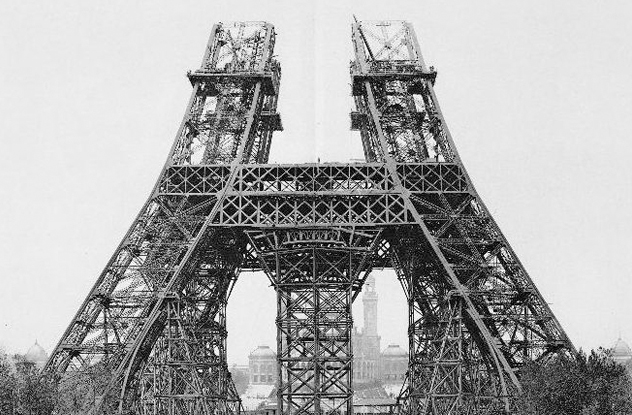
The French people were not always in love with their most famous building. In fact, many still aren’t, but public opinion has shifted in favor of the iconic Tour Eiffel.
When the tower was planned to commemorate the French Revolution for the 1889 World’s Fair, a public outcry erupted even before the foundation was set. Parisians of the time considered Eiffel’s proposed tower an eyesore and a blight on the scenic vistas of Champ de Mars. Petitions were circulated attempting to ban the project from even starting.
With the understanding that the tower would be disassembled within 20 years after the celebrations concluded, a reluctant community allowed the tower to be built. Despite a change of heart by citizens who began to appreciate the tower (and because the antenna tower proved to be an invaluable wartime resource), it narrowly escaped the worst again during World War II when Hitler ordered its destruction. The order was never carried out.
Today, the tower accepts visitors numbering over seven million per year, making it the most visited pay-for-entry monument in the world. It houses restaurants and gift shops on the second level and enjoys possibly the best view of the city from over 275 meters (900 ft) at the third level. Over 500 people work in and on the tower to maintain and run the monument every day, ensuring that the image will continue to grace the Paris skyline.
9The Sphinx
Lost Beneath The Sands
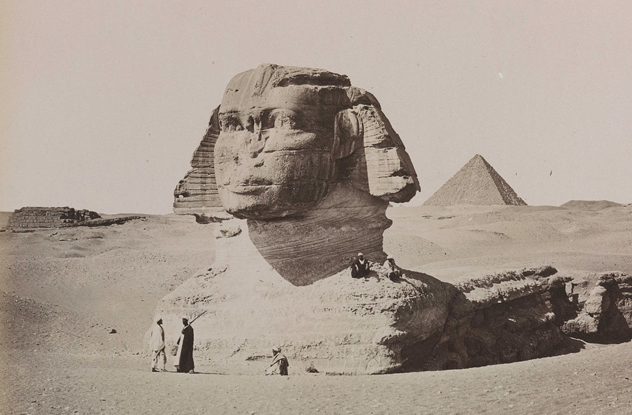
The Sphinx, one of the world’s most popular and easily recognized landmarks, was for centuries neither of those things. It has also suffered from neglect, vandalism, political turmoil, and natural erosion.
At over 4,500 years old, the Sphinx has seen much of human history unfold from its place near the famous Valley of the Kings. It was erected in connection with the Egyptian god Harmakhis, but the popularity of the cult that worshiped the deity waned, and the colossal sculpture was left unattended. It was buried beneath the shifting sands, and only the head remained visible, inspiring the moniker “father of fear” from locals who were disturbed by the unusual silhouette.
Over the centuries, the sands were removed and then left to overtake the monument again and again. One undocumented attack damaged the statue and destroyed the nose. Seeking gold and other treasures, the Sphinx was again unburied in 1817, but archaeologists found nothing and had to battle back the corrosive sands time after time. Worse, it was discovered that salt leaking up from the base was destroying the foundation of the Sphinx and compromising its stability.
The concrete used by the Egyptians had eroded, and the entire structure was in peril. Conservation efforts have replaced the original mortar with a stronger material, and the Sphinx is safe, for now.
8Statue Of Liberty
Stuffed In Storage
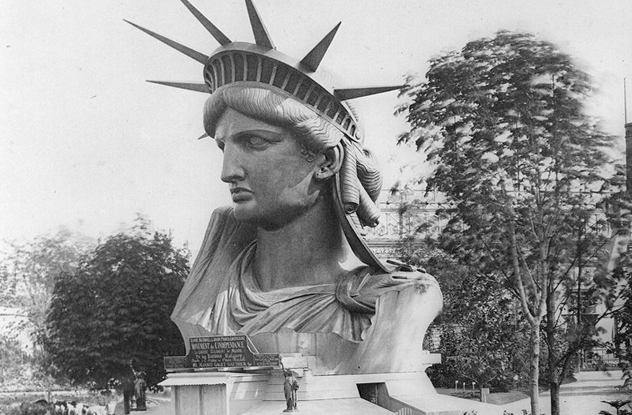
Millions of immigrants came from around the world to pass under Lady Liberty’s torch and find new lives in a nation that promised a better future. She has stood in the harbor attracting thousands of new visitors every year and representing the idealism of her country and its people.
You may know that the Statue of Liberty was a gift from France. This is both true and completely false. The artist, Auguste Bartholdi, originally approached Egyptian leaders during the World’s Fair with hopes of designing a massive statue to sit at the entrance of the Suez Canal. He was ultimately denied and searched for an alternative, turning to America with the hook of celebrating the young country’s independence.
It took 15 years and extensive fundraising to complete the statue, which was fully constructed in a Paris neighborhood with no significant funding from either government. In the end, Joseph Pulitzer saved the day by promising to print the names of every single contributor in his magazine. The plan worked. The gift was packed and shipped on the French ship Isere in 300 pieces in 241 crates across the Atlantic Ocean.
The cargo was nearly lost in rough seas. Once she reached the harbor, America’s icon was placed in storage for over a year. There it stayed, and there it would have remained indefinitely until it was de-mothballed and made the centerpiece of a publicity stunt, in which every person who donated to the cause of putting Liberty on her island got their name printed in New York World newspaper. Who could resist?
So bribery, luck, and good old-fashioned commercialism established America’s symbol in her current home.
7The Alamo
Bowie’s Blow-Up Plan
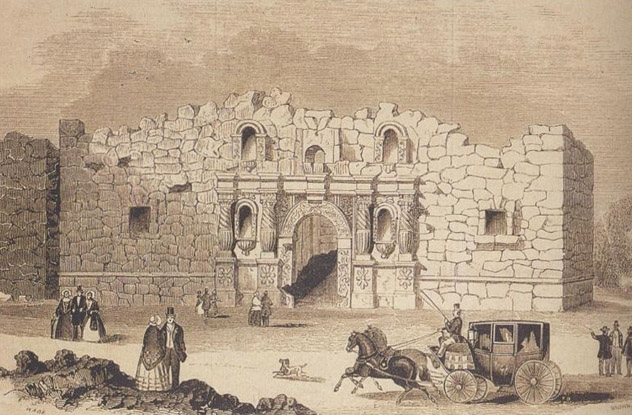
Remember the Alamo? Texas does, Mexico does, and Bowie sure did (Jim, not David).
The location that now stands as little more than the adobe facade of a once great building served many roles. Originally constructed as the chapel of the Mission San Antonio de Valero in 1718, it consisted of a few huts and a stone tower that was destroyed by a storm in 1724. The stone church building was constructed around 1744. It collapsed in 1756.
A second stone chapel, the one we see today, was started in 1758 and was slated to include two large towers and a domed ceiling, covering over four acres. It was never completed. Epidemics had reduced the population of Valero so much that not enough people were left to tend the building.
It was converted to a self-sustaining parish in 1793. It was stripped of its doors and windows and served as a parish for soldiers, eventually becoming San Antonio’s first hospital. A military unit—the Second Flying Company of San Jose and Santiago of the Alamo of Parras—gave the parish its modern name when they were stationed there for nearly 10 years starting in 1801 or 1802. Meaning “cottonwood,” the name has lasted for centuries.
The Alamo changed hands more than 16 times during battles between the Texan, Spanish, Mexican, Union, and Confederate forces that all fought for the land. What was left of the Alamo (probably only the first 7 meters (23 ft) of the walls that stand today) was almost completely destroyed for the last time when Sam Houston requested permission from Governor Henry Smith to remove valuable items and blow up the Alamo to keep it out of enemy hands. Smith refused, Houston left, Bowie stayed, and history was made. Bowie wrote to Smith on February 2, 1836 and stated, “Col. Neill & Myself have come to the solemn resolution that we will rather die in these ditches than give it up to the enemy.”
6The Washington Monument
Earthquake
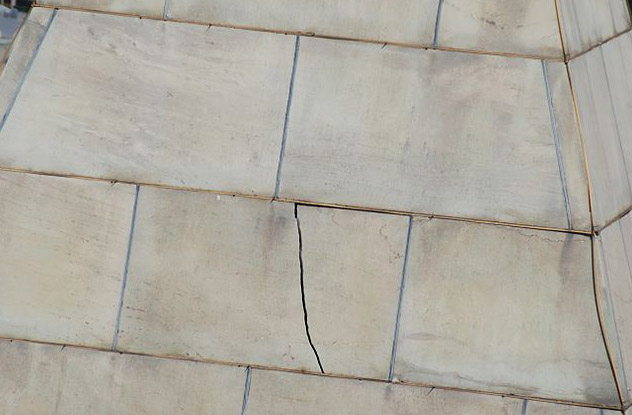
The Washington Monument was almost a lost treasure before it even began. As the result of early financial troubles in young America, Washington himself pulled the plug on efforts to immortalize him with the massive and expensive monument. Instead, he founded the city that would one day bear his name. Due to a succession of political blunders and the inability to finance it, nearly 75 years passed before any significant construction began, and even that was eventually abandoned.
Though a pared-down and far less expensive monument was finally constructed, it contained a substandard base structure. In 2011, the integrity of that structure was put to the test. A magnitude 5.8 earthquake struck near Washington, D.C., causing extensive structural damage that required the monument to be closed to the public.
According to a report requested by the National Parks Service, the monument suffered several broken marble panels that adorned the outside of the structure, particularly at the pyramid section. Vertical supports that ran inside the monument cracked, and pieces broke off. Portions of the exterior facade cracked and fell off due to twisting during the earthquake. The keystones were damaged, and pieces had to be completely removed. Structural supports known as ribbing inside the monument cracked at crucial joints, and gaps in the mortar became so extensive that daylight could be seen through them, leading to leaking and water damage.
Repairs were completed to the extent needed for it to reopen to visitors. At over 130 years old, the Washington Monument was not designed for earthquake resistance. Though it was patched and approved by the NPS, another incident could prove disastrous for the landmark.
5The White House
Tornado
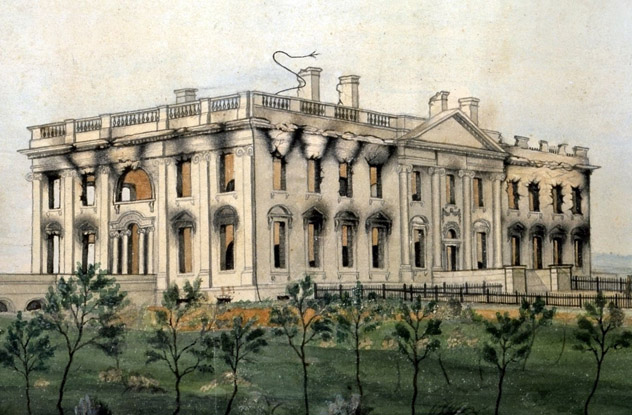
Historians remember with regret that the White House that stands today is actually only a shell of the original building, which has been burned, gutted, and restored many times throughout history. The worst destructive act on the country’s most famous residence was in 1814, when British soldiers invaded Washington, expelled all the residents, and set fire to the Capitol and the White House along with other public buildings.
The story of how the White House barely escaped complete ruin at the hands of the British army defies logic, common sense, and even science. Union forces were scattered in the wake of the attack, and Washington appeared to be lost. Then came one of the most remarkable and unseasonable weather events in American history.
On August 25, 1814, two days after the siege began, a tornado hit downtown Washington, D.C. Its torrential rains doused the fires and disrupted British forces, slamming their ships and throwing their cannons into the air. More British troops were killed by the storm than by gunfire.
Following the unexpected gale, the invading army retreated to its ships to regroup, left harbor, and never returned. Up to three tornadoes hit that day—quite an oddity, considering that only seven made landfall in the following 200 years.
4Taj Mahal
Military Armament
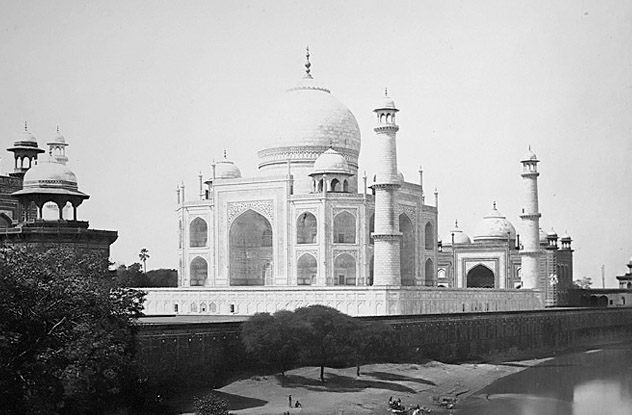
It’s shocking to hear the lengths former leaders and the public of Agra went to disgrace their country’s most famous monument. The Taj is now considered a must-see for travelers to India, a priceless remnant of the past, and a testimony to the enduring power of love. But it was nearly destroyed several times, defaced for decades, and the object of scorn by many former leaders.
Built as a tomb for the wife of former leader Shah Jahan, the monument was one of the grandest achievements of its time. After the emperor’s death, the memorial was ignored and fell into disrepair. The British intervened and converted the monument into a military compound. Marble facades were destroyed, barracks were built on the grounds, and the forts were converted into garrisons. In an effort to impress the Prince of Wales, the hall was painted in a coat of whitewash.
After their departure, plans were submitted to have the Taj destroyed and a government building erected in its place. Those plans were abandoned, but the destruction continued. Picnics, fairs, and other events were held on the grounds, where revelers would chisel away pieces of the adornments to take as souvenirs.
In 1828, Lord William Bentinck declared that many landmarks were to be destroyed and sold off in pieces in London. Several pavilions of the Taj were stripped to the brick and shipped off to Europe, some going to King George IV himself. Wrecking equipment was moved into place, and the Taj was ordered to be destroyed. Luckily, just as the crews began, auction attempts in London were declared a failure, and the project was abandoned.
In the early 1900s, Lord Curzon was shocked by the monument’s condition. He had it restored to its current state along many other mosques and tombs that had been turned into kitchens, police stations, and ticket offices. In 1983, the Taj was declared a UNESCO World Heritage Site.
3The Colosseum
Struggles Against Time
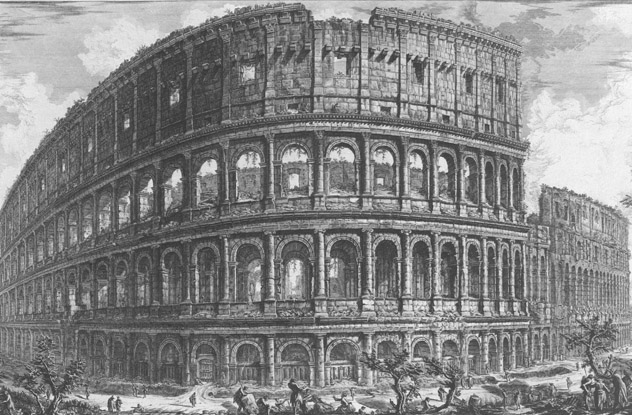
The Colosseum in Rome, also known as the Amphitheatrum Flavium, has undergone as much structural damage as any building could while remaining standing. It’s nearly 2,000 years old, and the remaining two-thirds of the original Colosseum is a testament as much to the engineering prowess of ancient Romans as it is to conservation efforts.
The Colosseum has suffered not one but two direct lightning strikes that burned out the wood support structures and gutted the basement added by Titus’s brother Domitian. It took every firefighting official and member of the naval fleet to put out the flames and barely avert complete destruction. The fires also greatly damaged the stones and mortar holding the amphitheater together. It was decades before repairs were complete.
The greatest damage has come from people and time. The Colosseum narrowly escaped destruction at the hands of Christian emperors due to its significance as the death place of many Christian martyrs. This did not prevent it from being stripped bare of its impressive marble facade to be used in monuments and houses of the new elite class. The iron supports were stolen by robbers who sold them as scrap, and centuries of turbulent ground shifting has cracked and crumbled the remaining stones into certain peril. It was recently discovered that, a lot like a neighboring attraction in Pisa, the Colosseum leans—it’s 40 centimeters (16 in) higher at one end.
A conservation effort aims to reverse the damage caused not only by years of neglect but by subways and traffic whose vibrations compromise the Colosseum’s structural integrity. The initial effort was postponed several months as pieces of the Colosseum were already being found to fall from its walls.
2The Golden Gate Bridge
High Winds
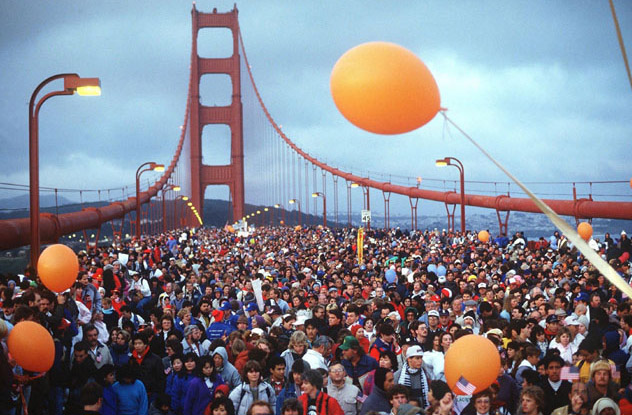
On the 50th anniversary of the Golden Gate Bridge in May 1987, 300,000 people marched across the asphalt. Witnesses experienced motion sickness as the bridge swayed in the wind and the deck dropped by more than 2 meters (7 ft). Though no one made a big deal out of it at the time, saving a scene of mass panic, the bridge itself, normally curved, appeared to completely flatten from the side.
Engineers stated that there was no real danger. Each foot of the Golden Gate Bridge can comfortably withstand 2,600 kilograms (5,700 lb) of weight, while the marchers only exerted about 2,450 kilograms (5,400 lb) of weight on each foot of the bridge.
The bridge was actually more endangered (but never quite destroyed ) during its construction than it was that day. Scaffolding and dangerous tide problems during the foundation’s construction killed 911 workers. Then in 1951, the entire road was closed down for several hours when winds reached 113 kilometers (70 mi) per hour, causing the bridge to flutter. A sister bridge from the same designer as the Golden Gate, the Tacoma Narrows, had collapsed on film from winds reaching 65 kilometers (40 mi) per hour 10 years before this incident.
Structural damage occurred on the Golden Gate, while the winds bent the bridge so much that the light standards near the center touched the support cables. The bridge was almost destroyed, according to former Golden Gate chief engineer Daniel Mohn. The added weight of traffic could have resulted in catastrophe had officials not acted quickly.
1The Leaning Tower Of Pisa
War Orders
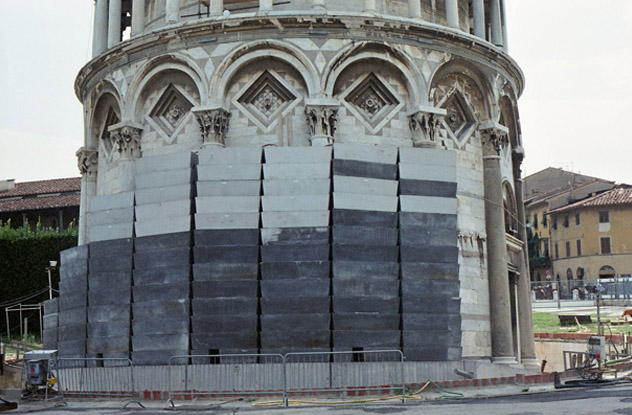
Many of wonders of the ancient world met their demise during intense battles. In modern times, countless artistic treasures are still missing after being misplaced during the height of war.
The famous Leaning Tower of Pisa nearly became one of those casualties. But it wasn’t bombings or the collateral damage normally experienced during firefights that nearly reduced to the tower to rubble. It was an order given to Sgt. Leon Weckstein by higher-ups during World War II.
The troops battling back Nazis in Pisa were ordered to eliminate all buildings that may have potentially served as sniper nests for German soldiers. Weckstein says that he received the command to blow up the tower and nearly did so except for overbearing heat. The heat was so intense that it was impossible to properly aim. After delay, he finally did take aim on the monument, but the troops were bombarded by enemy fire and forced to retreat. Military brass approved the fallback and spared the tower.
Whether the German soldiers had ever been in the tower is not known, but Weckstein’s procrastination bought the landmark just enough time to be spared a violent and unnecessary end. Today, efforts are underway to maintain the leaning tower, which has to be corrected every so many years to keep it from simply toppling over.
+The Kremlin
Blown Up

The Kremlin in Russia is considered to be of the most architecturally significant landmarks in the country. Home to the ruling family from its inception, the Kremlin (“the town”) marks the spot where Moscow was founded in the 11th century. Protected by a fortifying wall and moat, the Kremlin became the center of development for what would become the future capital city.
During the battle of 1812, the Kremlin was captured by Napoleon and nearly became his residence prior to the French retreat. On his departure, Napoleon ordered that the Kremlin be blown up. His plan nearly succeeded. However, a timely rainstorm dampened many of the fuses. Other explosive caches were discovered by residents who put out fires.
Still, the building did not escape unharmed. Five explosions rang out, destroying much of the structure and causing lasting damage. Two of the fortifying towers were demolished, the arsenal was partially collapsed, and several government buildings were damaged in the explosions. The initial blast, the strongest of the five, was so powerful that not only were all of the windows and glass in the Kremlin and neighboring buildings shattered—the window frames themselves were blown out.
Though the building was badly damaged and extensively burned, the residents of Moscow dedicated themselves to resurrecting the iconic landmark. It took decades of restructuring to finish the repairs, but today, the Kremlin stands a testament to the resolve of a centuries-old city and its proud inhabitants.
Twitter: @JSGestalt








